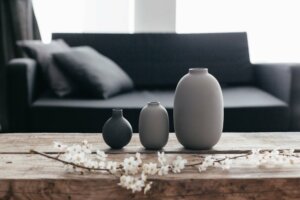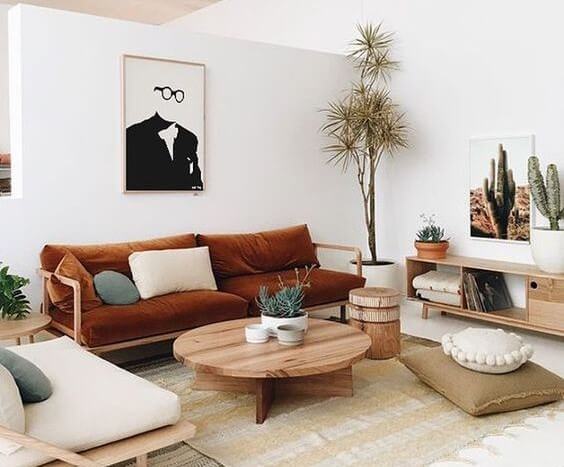On Trend: The Japandi Style

The word Japandi is a play on words. Japan is a country in East Asia and ‘di’ comes from the Scandinavian language. Therefore, it’s understood that this style is a combination of designs from both places.
Specifically, the Japandi style is a mixture of the best wabi-sabi with the best of Scandinavian minimalism. The result? Spacious, bright, harmonious interiors and, above all, very functional.
The one great advantage that this particular style offers is that it’s very easy to adapt to any home. It’s a simple, neat, cozy interior decor and very calming.
The Japandi style: a welcome novelty
The fact that the Japandi style is a novelty in the world of decoration is, in fact, a half-truth, because in reality, it’s a reinvention of other styles.
And although Japanese and Scandinavian styles seem very different, the truth is that they complement each other perfectly. They have many points in common and, together, they transmit values and positive feelings, which is very interesting.
Simple and functional harmony

Since both decorative styles avoid clutter and unnecessary luxuries, one of the main features of the Japandi style is simplicity. However, this doesn’t mean that it doesn’t permit certain ornaments or accessories, rather, it doesn’t incorporate them in a superfluous way.
The decorative accessories of the Japandi style are discreet in size, shape, and color. In fact, with regard to color, it should be noted that they follow the predominant tone of the room. Therefore, they blend perfectly with the environment in general.
In other words, ornaments and accessories should create a subtle presence that doesn’t detract from anything else. The idea is that everything complements each other.
Thus, the Japandi style spaces are wide and easy to navigate, where comfort becomes the protagonist of each and every room. The result is a spacious and functional home that’s perfect for day-to-day living.
Far from what we may imagine, the rooms don’t convey a feeling of emptiness nor are they impersonal. The furniture, decor, and materials used should create a warm and homely atmosphere.
The Japandi style accessories

The accessories that integrate well into the Japandi style are handcrafted pieces and plants. However, inherited items can also be used to add greater sentimental value and increase the feeling of personality and warmth. Of course, everything should be used in proper measure, without any exaggeration.
In this decorative style, the famous, “less is more” should prevail. This is because the room must transmit simplicity, harmony, and peace.
A connection to the earth

Influenced by Japanese decoration, the Japandi style tends to place most objects close to the ground. It’s common for sofas and beds to lack a box spring, legs, or any structure that can raise them off the ground. If you have furniture with legs and want to conform to the Japandi style, the legs should be as short as possible.
According to Japanese tradition, this way of furnishing your home is beneficial for the people who live in it, since it contributes to maintaining a connection with Mother Earth.
Wood: the main Japandi style material

Given that minimalism is key, it’s necessary to provide warmth and a homely feeling through the use of wood. This material isn’t only timeless but is also capable of counteracting any possible perceptions of austerity.
All the furniture in the Japandi style is generally made of wood, although depending on where the wood originates from, its tone can vary considerably. As with the Scandinavian minimalist style, light-colored wood is commonly used.
Other materials widely used in Japandi decor are rattan, bamboo, paper, and ceramics. It’s necessary to clarify that in the Japandi style the use of folding screens and other types of room dividers are very common.
As you’ve seen, Japandi is a very attractive style in the world of interior design. Since 2017, many homes have adopted it for simplicity and warmth. Would you like to emulate this style too?
The word Japandi is a play on words. Japan is a country in East Asia and ‘di’ comes from the Scandinavian language. Therefore, it’s understood that this style is a combination of designs from both places.
Specifically, the Japandi style is a mixture of the best wabi-sabi with the best of Scandinavian minimalism. The result? Spacious, bright, harmonious interiors and, above all, very functional.
The one great advantage that this particular style offers is that it’s very easy to adapt to any home. It’s a simple, neat, cozy interior decor and very calming.
The Japandi style: a welcome novelty
The fact that the Japandi style is a novelty in the world of decoration is, in fact, a half-truth, because in reality, it’s a reinvention of other styles.
And although Japanese and Scandinavian styles seem very different, the truth is that they complement each other perfectly. They have many points in common and, together, they transmit values and positive feelings, which is very interesting.
Simple and functional harmony

Since both decorative styles avoid clutter and unnecessary luxuries, one of the main features of the Japandi style is simplicity. However, this doesn’t mean that it doesn’t permit certain ornaments or accessories, rather, it doesn’t incorporate them in a superfluous way.
The decorative accessories of the Japandi style are discreet in size, shape, and color. In fact, with regard to color, it should be noted that they follow the predominant tone of the room. Therefore, they blend perfectly with the environment in general.
In other words, ornaments and accessories should create a subtle presence that doesn’t detract from anything else. The idea is that everything complements each other.
Thus, the Japandi style spaces are wide and easy to navigate, where comfort becomes the protagonist of each and every room. The result is a spacious and functional home that’s perfect for day-to-day living.
Far from what we may imagine, the rooms don’t convey a feeling of emptiness nor are they impersonal. The furniture, decor, and materials used should create a warm and homely atmosphere.
The Japandi style accessories

The accessories that integrate well into the Japandi style are handcrafted pieces and plants. However, inherited items can also be used to add greater sentimental value and increase the feeling of personality and warmth. Of course, everything should be used in proper measure, without any exaggeration.
In this decorative style, the famous, “less is more” should prevail. This is because the room must transmit simplicity, harmony, and peace.
A connection to the earth

Influenced by Japanese decoration, the Japandi style tends to place most objects close to the ground. It’s common for sofas and beds to lack a box spring, legs, or any structure that can raise them off the ground. If you have furniture with legs and want to conform to the Japandi style, the legs should be as short as possible.
According to Japanese tradition, this way of furnishing your home is beneficial for the people who live in it, since it contributes to maintaining a connection with Mother Earth.
Wood: the main Japandi style material

Given that minimalism is key, it’s necessary to provide warmth and a homely feeling through the use of wood. This material isn’t only timeless but is also capable of counteracting any possible perceptions of austerity.
All the furniture in the Japandi style is generally made of wood, although depending on where the wood originates from, its tone can vary considerably. As with the Scandinavian minimalist style, light-colored wood is commonly used.
Other materials widely used in Japandi decor are rattan, bamboo, paper, and ceramics. It’s necessary to clarify that in the Japandi style the use of folding screens and other types of room dividers are very common.
As you’ve seen, Japandi is a very attractive style in the world of interior design. Since 2017, many homes have adopted it for simplicity and warmth. Would you like to emulate this style too?







